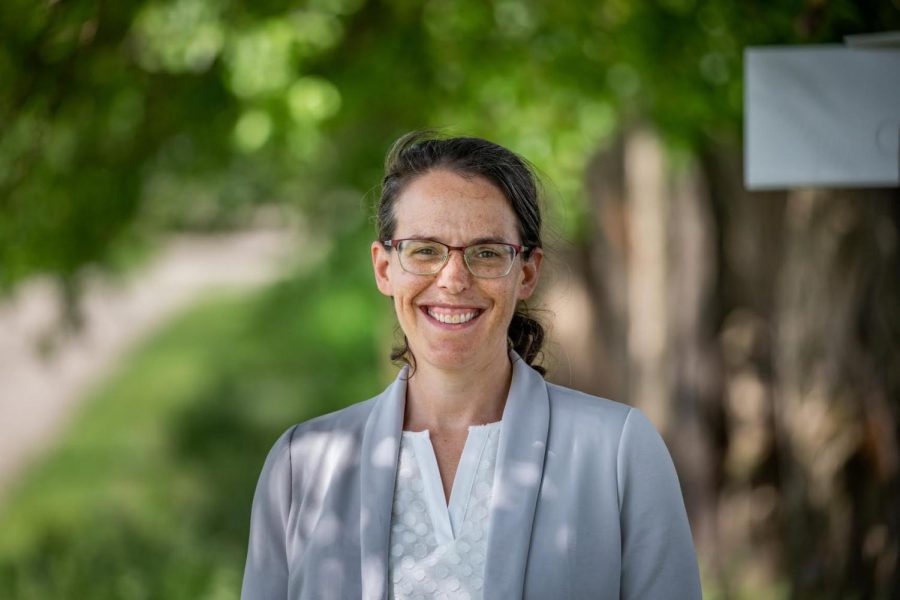UI epidemiologist clears COVID-19 testing, research misconceptions
Photo Courtesy of Illinois News Bureau/Fred Zwicky
Dr. Rebecca Lee Smith poses for a professional headshot. Smith explained that false positive COVID-19 results are highly unlikely.
March 11, 2021
The University’s COVID-19 research and testing efforts are widespread, both in range and recognition. However, the process behind the University’s saliva-test might leave patients wondering what happens in the time between when the spit goes to the lab to when results are given.
Confusion on testing processes can lead to misconceptions about the results, such as the common saying that someone received a ‘false positive’ COVID-19 test. Dr. Rebecca Lee Smith, epidemiologist and associate professor in Veterinary Medicine at the University, explained how unlikely false positive results are.
“A lab worker will look at the results of the test,” Smith said. “If a sample comes back positive, we run the test again. Nobody gets positive results until they’ve been tested twice.”
Due to the retesting protocol, false positive results are very rare. SHIELD reports that the saliva test has a sensitivity of 97%, the ability to correctly identify those with COVID-19, and a specificity of 99%, or the ability to correctly identify those without COVID-19. Paired with the ease of testing, low cost and speed of results, the saliva test is praised for being an accurate alternative to nasal swab testing.
However, the saliva test is more complicated than a lab worker reading the results on a singular machine. The process involves a lot of robotic precision and programming, but it begins with a bath.
Get The Daily Illini in your inbox!
“When the rack that you put your tube in comes to the lab, it goes into a hot water bath,” Smith said. “It basically gets boiled for 30 minutes.”
This bath deactivates the virus and makes it safe to handle, but it has other purposes as well. Boiling the samples is critical to make the virus identifiable.
After this, your sample goes into a series of robots. The first takes the caps off of the tubes and moves the saliva around while adding other materials. The second passes the samples to a PCR machine, which amplifies segments of DNA.
“We look for three different genes (in the DNA),” said Smith. “At least two of those have to be amplified to get a positive result.”
After a lab worker reads the results on the Polymerase Chain Reaction machine, negative test results are sent out and samples without the virus are destroyed. If the machine reads positive, the sample is put through the process again. When it comes back positive for a second time, the result is sent out and the positive sample is banked for later testing.
In total, SHIELD has performed over 1.5 million COVID-19 tests with a current positivity rate of 0.1%. The University saliva-based test was also recently approved for emergency use by the FDA.
However, while many know of the University’s research efforts, knowing how they help is another story. Dr. Smith said that the research being conducted in the area is unlike anything else being done internationally.
“The work we’re doing operationally with the SHIELD program is really important for stopping the spread within the community because we’re finding cases before they transmit to too many people,” Smith said. “We’re helping them to isolate quickly, and we’re identifying infections much sooner on average than anybody else.”
SHIELD consists of three committees — Target, Test and Tell. Smith co-leads the Target team.
“Our purpose is to figure out who to test and when,” she said.
The Target team also manages public messaging. SHIELD works directly with Carle Hospital and Champaign-Urbana Public Health District to communicate about rates and prevention in the community.
While the University’s saliva test is incredibly accurate and research is helping slow the spread, COVID-19 still remains a risk to everyone in the community. When asked for advice regarding the pandemic, Smith emphasized minimizing contact with others.
“Don’t share air with people outside your family or household,” Smith said. “Masks, distance, limit your contacts.”







